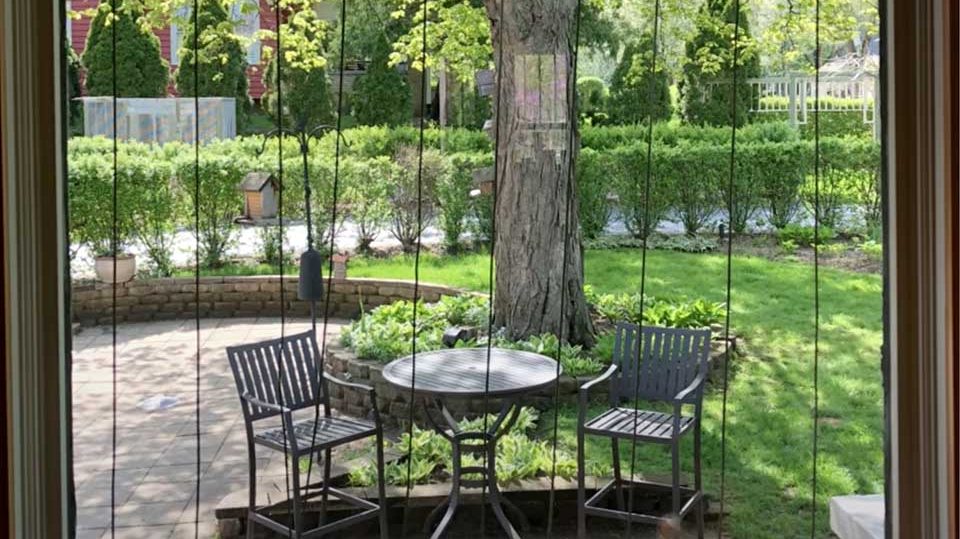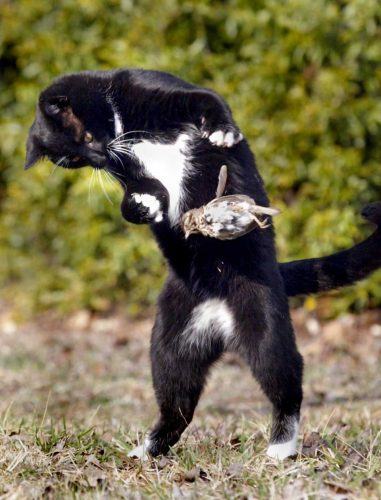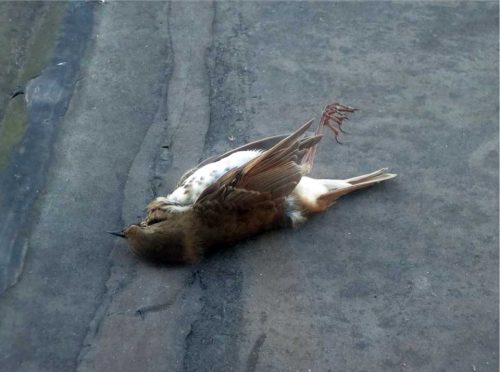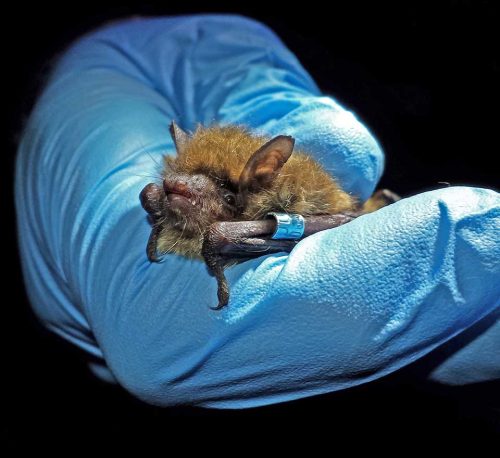Picture-Perfect… and Bird-Friendly
Read about the main causes of bird demise and how you can help turn the tide. By J. Morton Galetto, CU Maurice River


As a child I remember watching the TV show Sing Along with Mitch, which was on television from 1961 to 1966. Families tuned in on Sunday evening to sing songs as lyrics appeared on the bottom of the screen. Mitch Miller, an affable goateed musical conductor, was the host. For younger readers, think karaoke. Every show ended with “Be Kind to Your Web-Footed Friends;” the lyrics continued on… “for a duck may be somebody’s mother.” The cast of singers marched as they sang the tune, like a little flock behind Mitch.
At parties in those days it was common for people to gather around a piano and sing. There were normally a few who could hold a tune, others who became uninhibited after a stiff drink. Occasionally someone would reinvent lyrics and often the “web-footed friends” became “Be kind to your fine feathered friends.” There were also standard singalong piano tunes like “I Want a Girl, Just Like the Girl That Married Dear Old Dad,” and “On the Way to Cape May.” So allow me to let these two tunes act as themes for this week’s story. Corny? Yes, but let’s just go with it.
Even at the young age of seven I felt compelled to help our avian friends. Did I know then that they were indicators of our own health? Surely not. Did I know their colors and songs gave me great joy? Yes. Could I anticipate that from 1970 to 2019 the North American Bird population would drop by 25 percent, and that there would be three billion fewer breeding adults? Absolutely not; I couldn’t even conceive of three billion anything, nor can I now. But the scientists at Cornell’s Lab of Ornithology have the statistical evidence to show this dramatic decline.
Things have become very dismal for birds. Whatever happened to “Be Kind to Your Fine Feathered Friends?” This week’s story is about optimism and how you can help. But first let’s set the stage as to why your participation is especially apropos.
If you live in southern New Jersey you are geologically part of the Cape May peninsula. And when it comes to autumn our avian friends are “On the Way to Cape May” as they fly to their wintering grounds.
Ornithologists and bird enthusiasts use the term “migrant trap” for areas where birds congregate before their seasonal moves. Neotropical birds moving north in the spring cross the Gulf of Mexico and arrive, exhausted, on the Gulf Coast in the State, typically seeking rest, food, and shelter on the live-oak trees of barrier islands. When large numbers of migrants congregate these are called a “fallout.”

Peninsulas and edges of estuary borders are fallout places. And in southern migration they are resting and fueling stops before the travelers make their watery crossings on the southward journey. Peninsulas also effectively funnel birds in large concentrations in places like Point Pelee, Ontario; the Florida Keys; Point Reys, California; and yes, Cape May, New Jersey, resulting in these locales having reputations as birding hotspots.
With songbirds much of migration is at night and elusive. However, many hawks will make use of thermals to cross the bay and for that daylight is necessary. Birdwatchers and wildlife enthusiasts will view migration from the Hawk Watch Platform in Cape May Point State Park. If you are new to watching hawks, no problem—birders simply love to share. Late-September to mid-October are the peak times to observe the phenomena.
We are in the midst of a flyway migration fiesta and we have plenty of year-round birds too. This means you can play a role in changing the paradigm from declining bird populations to stable or increasing numbers. Thankfully birds can be resilient, but only if changes are made. For each threat to birds, there are ways we can improve their survivability.
Improve or Create Habitat: The primary cause of decline is the destruction of habitat. Your yard is an opportunity to support birds and other wildlife by planting native species and providing food, shelter and water. Since we are coastal and have lots of streams, rivers, and lakes, water is generally in good supply. However you may choose to add a bird bath, mister, or pond. Native trees, shrubs and plants are also key to bird survival.
Shrubs and stick/brush piles can provide shelter. Plants will attract insects that are essential foods for some species. Fruits, berries, seeds and other forest mast provide forage. Famed entomologist Douglas Tallamy promotes a vision based on a premise: Private property owners collectively own the most land in the United States, and if each of us provides habitat, together we could create America’s largest national park. Wow!
So what if you don’t have property? You can adopt a pocket park, median strip, or natural area near you. You can join a citizen group that is already improving habitats. If you aren’t able to physically participate, you can support others who do, either with funds, advocacy, voting, or some combination of all these endeavors.
Keep Cats Indoors: Scientists and avian conservation groups have determined that free-roaming cats collectively have a devastating impact on bird populations. They rank second only to habitat destruction as a cause of bird population decline. Cats kill 2.6 billion birds a year in the United States and Canada (some scientific sources suggest that the number may be as high as 4.0 billion). Feral cats are also responsible for a number of extinctions and endangered populations of wildlife, killing between 6.3 billion and 22.3 billion mammals a year in the U. S.
In study after study wildlife biologists agree that trap, neuter, and release does not work. Most veterinarians concur that the life of an outdoor cat is greatly diminished in quality compared to a well-cared for indoor cat—even cruel. They are domestic animals. Keep them indoors!

Window Collisions and Lights: The next major culprit contributing to the decline of birds is window collisions and lights, in tandem and alone. Most song bird migrations take place at night, and sadly birds are disoriented by artificial illumination. City lights, large communication tower lights, and house lighting can result in navigational errors for migrating birds. Simply turning off unnecessary lights will save significant numbers of birds.
The vast majority of daytime deaths are caused by homes and low-rise buildings, not large commercial structures. In particular birds see their habitat reflected in windows and fly into them. More than a billion birds a year are killed by these collisions.
Stenciling windows can help with daytime impacts. Christine Sheppard of the Bird Conservancy relays that the spacing of stenciling or decals is critical, since birds have to perceive the obstruction. Most sources are recommending spacing of no more than two to four inches apart. Raptor stencils are unlikely to work because they aren’t seen as a bird of prey or an obstruction.
Decals that reflect ultraviolet sunlight, seen by birds but not by humans, are gaining in popularity. You see the decal but not in the same way the bird perceives it (many have become available online in only the last four months).
Cornell gives numerous ideas on how to deter bird window strikes; one is “zen curtains,” which are closely spaced ropes that hang over windows. These looked surprisingly nice in pictures of their headquarters. Another product they encourage is FeatherFriendly.com that uses dot-like decals; these too seem aesthetically pleasing.
Some plate glass companies are making ultraviolet window glass with patterns that are visible to birds but not to people.
Avoid Pesticides: Pesticides are toxic to birds. Insect prey and seeds allow birds access to toxins such as neonicotinoids and glyphosate (Roundup™).
Feeding Birds: The best way to support birds is by providing habitats that attract food such as insects, or are food, such as berries. Again native plantings are key to success.
If you choose to supplement their food with feeders, the primary concern is keeping them and the general areas clean. Most species of birds prefer to feed on the ground, and it is important to rotate the area where you place the seed. It is also important not to feed birds things they shouldn’t have, such as bread and donuts. Avocado, caffeine, chocolate, salt, fat, fruit pits and apple seeds, onions and garlic are all toxic to birds. Consult with knowledgeable sources before offering birds food. People are sometimes concerned that keeping feeding stations replenished as the seasons change may deter birds from flying south in time, but birds have evolved to migrate so this is not an issue.
Feeding stations have traditionally been accepted by the birding community. However they can lead to problems, and although I do think that bird feeders foster an interest in nature for children and adults, I can tell you that if you live in bear country, feeding our feathered friends is a mistake.
Citizen Science: There are endless tools that people use to track birds and record their sightings. The most popular of these is “ebird,” a Cornell phone application that helps you identify birds specific to your location. People are encouraged to adopt a patch and record sightings there. The accumulation of this data continues to give insight into the presence and movement of birds. You can develop a checklist wherever you bird.
There are many ways to be kind to your web-footed friends and their avian comrades. Why not strike up a chorus of “On the Way to Cape May” with a friend and head to the Point to witness this season’s migration. It is when we experience the wonder of birds for ourselves that we are most compelled to see them endure for future generations to enjoy.
Sources
- Seven Simple Actions to Help Birds, Cornell Lab of Ornithology
- Group works to make campus windows bird friendly, By Krishna Ramanujan, Cornell Chronicle, May 2, 2023
- “A Wing and a Prayer: The Race to Save our Vanishing Birds” is a book by Anders and Beverly Gyllenhaal
- American Bird Conservancy: Cats Indoors. State of the Birds 2014 Report.
- Estimated Number of Birds Killed by House Cats. Blancher 2013. Avian Conservation and Ecology.









